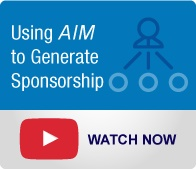One of the greatest challenges of implementing large-scale, complex change is that very often you will be confronted with multiple Sponsors. They all bring their own visions, political agendas, and "Frames of Reference" to the change. Some are stronger than others. How many of these scenarios sound familiar?

- Your Sponsor signs off on the change strategy but then is “too busy” to be involved on a deeper level
- Your Sponsor embraces his/her role as figure head, but doesn’t see the need to be an active participant of the change
- Your Sponsor says he supports the change, but models and reinforces the “same”
The cascade of committed Sponsors from the top down is the most critical success factor in ensuring a fast and successful implementation of any type of business change. So when your Senior Managers, Directors, and VP’s are difficult to manage, are sources of resistance themselves, or become just outright hard to pin down, progress on your change can easily slow down or completely stall out.
5 Actions to Address Weak Sponsorship
So what to do when faced with Sponsors that are either unwilling or unable to do what you need? Here are 5 actions you can take to overcome this all too common barrier to change.
- Educate Your Sponsors
Many Sponsors are simply not aware of what it takes to be a good Sponsor! Some may think implementation is the responsibility of Change Agents, and they can sit back and just assume it is happening “out there,” without realizing that in reality, it is their actions of Express, Model and Reinforce that control the speed of the implementation. Here are several ways you can educate Sponsors on their role:
Training: One of the most direct ways to confront this issue is to offer training to your Sponsors. IMA’s Executive Briefing and SponsorShop programs are change management training sessions aimed at educating your Sponsors on their role and accountabilities.
Motivation: Even for Sponsors, the motivation to implement must be stronger than the motivation to stay the same. Motivate your Sponsors by providing reinforcements that align with these expectations and by "turning the motivation dial" toward creating a situation of discomfort or pain for staying the same.
Sponsor Contracting: Contracting is the framework (the exchange of offers, wants, and needs) for the discussions you have where you ask for what you need. Contract with Sponsors for what you need from them right now, and limit your list of requests to 2-3. You will need different things from your Sponsor at various points of the change, so it makes sense to let your Sponsor know you will be back!
Performance Management: Managers are just like everyone else-- they do something because they are or were reinforced for it in some way. The new reinforcements must be aligned with getting these Sponsors to Express, Model, and Reinforce their demonstrated commitment to the change.
- Replace Your Sponsor Dependence
If one of your Sponsors is weak, try sequencing your implementation by working where you do have good Sponsorship first. Remember, you can build coalitions lower down in the organization with other strong "Reinforcing Sponsors." If necessary, you can go up one level to avoid the black hole created by the weak Sponsor. Going up one level is the last choice though, because it will slow you down.
- Focus on Damage Control
Recognize the limitations of your situation, and ask yourself, "Given these limits, how do I get as much accomplished with what I have?" In other words, “How can I scotch tape this together with the Sponsors that I do have?” It may not be pretty, but sometimes it is all you can do.
- Build a Critical Mass of Champions
Change Champions are anyone within the organization who believe in and want the change. The more people who champion the change, the more pressure your Sponsor will feel to make the change happen. However, a word of caution… it can take a long time to build sufficient numbers to be effective. So the downside is that this tactic may affect your ability to implement at speed.
- Have Patience
While a good Change Agent is by nature action-oriented, sometimes you just need to have patience while you continue to do the other four recommended suggestions. Sponsors come and go, and you may have to wait until this one leaves, or a bigger, (hopefully more committed) Sponsor comes in and takes over.
If you are a Change Agent faced with an imperfect Sponsor situation (and who isn’t?), the above 5 actions can provide you with the forward movement you are looking for. But it will likely require a combination of all five of these actions if you are going to get any level of acceleration. Do you have a weak Sponsor in your organization? What’s your strategy for doing something about it?


